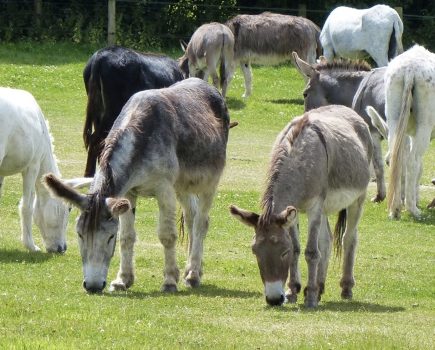Alan Beat talks about managing manure on a smallholding
Livestock manure has been the main source of soil fertility for millenia, reaching a peak during the Victorian period of ‘high farming’ when over-wintered stock produced everlarger quantities of manure that fertilised increasing yields of arable crops, in a virtuous circle of rising all-round productivity. Only for the last century or so has the dominance of manure been challenged by cheap artificial fertilisers, and then only in affluent western societies. Meanwhile, the growth of industrialised farming has ironically transformed this most valuable of resources into a gross pollutant that damages the environment it once enriched. At the smallholding level, manure remains the most cost-effective general purpose fertiliser for field and garden, and can make a significant contribution to the health and well-being of all who live there, including ourselves; so it’s worth making the effort to manage it well. Sources Livestock manure can be broadly divided into two categories: the waste of herbivores such as cattle and sheep, or that of omnivores such as pigs and poultry. Herbivores consume and process large quantities of fibrous plant material of relatively low nutrient value, while omnivores eat smaller quantities of higher nutrient value foodstuffs. The resulting manures reflect this difference, so omnivores yield richer manure. I can illustrate this with an anecdote involving a close friend, who once spotted a sign at a visiting circus announcing ‘free elephant dung’. Wow! he thought, this will boost the rhubarb, so he set to work with a wheelbarrow and filled his compost bay withthe magic substance. To his surprise, the huge pile shrank over time to a layer just a few inches deep, but he consoled himself with the thought that this would be marvellous stuff. In fact, when he applied it to his garden, the results were so disappointing that he never bothered to collect it again! Farmers of old understood the difference. William Cobbett has this to say in Cottage Economy published in 1821: “The fatting of a large hog yields three or four loads of dung, really worth more than ten or fifteen of common yard dung. Without hogs, farming could not go on, and it never has gone on in any country in the world. Hogs are the great stay of the whole concern . . . without them the cultivation of the land would be a poor, a miserably barren concern”. No-one is suggesting that the manure of herbivores should be ignored – on the contrary, it has a valuable contribution to make. As with most things in smallholding, variety is important, and the inclusion of some waste from omnivores will boost the overall value of the resulting manure. Housed stock It is when livestock are housed or yarded that their manure becomes readily available for collection, storage and re-use. In fact, there is a strong argument for housing some livestock, some of the time, for the purpose; and this was the very basis of Victorian high farming already mentioned, at the heart of which lay the yarding of cattle on straw to produce copious quantities of manure. On our smallholding, we have particularly noticed the difference when pigs have been free-ranged instead of housed, with their dung absent from the manure heap as a consequence. The field may be richer, but our garden has definitely been the poorer.Heap, windrow or bay When we first moved into smallholding, I made the time-honoured open heap in a field corner, throwing on the soiled bedding as livestock housing was cleaned out through the seasons. A major constituent was soft rush, juncus effusus, that we use in place of straw. This grows in abundance across our wetter ground and is harvested rather like hay, being cut, turned until really dry, then baled for storage. It costs very little and is chemical free – just you try buying organic straw! Used generously as bedding, this ends up on the muck heap mixed with dung and urine. But a year after starting my first heap, I found that it had only partially rotted down, with the centre especially remaining little changed from its original state. I tried covering the heap with discarded black polythene silage sheet from a neighbouring dairy farm, but one year on, this was even worse, with most of the material remaining largely unchanged while only the base, in close contact with the soil, had decomposed. I discarded the sheet and watered the next heap as it was built, using a hose to soak each layer. This was a definite improvement, with partial decomposition throughout, but still the process was more advanced close to the outer surfaces. Turning the heap seemed the obvious answer, but that would be hard manual work and plenty of it! I learned that organic farmers often compost their muck in ‘windrows’, making long raised heaps that are turned by tractor hydraulics to provide the necessary aeration. But on our wet ground, using a tractor in this way risked damaging the land too much, so I looked for another solution. Trying to minimise the workload, I built a muck bay situated between animal housing and the garden where most of the resulting manure would be used, to cut down the barrowing distance. Laying a concrete strip to the baywould provide tractor access in all weathers. Now I could fork out the soiled bedding into the transport box of the tractor, drive to the muck bay, raise the box on the hydraulics as the heap rose, and simply fork out the bedding. It was relative bliss! The muck bay measures 10 feet square with old railway sleepers set vertically at the four corners. A few scrap lengths of wood are nailed horizontally to form three very open slatted sides, just enough to contain the material while allowing maximum exposure to the air. The open front has a drainage gully at the concrete lip to collect liquid run-off, which is directed through a buried pipe to feed the roots of a nearby pear tree (and you should see the fruits!) Once the ewe flock has finished lambing, I muck out their housing into the empty bay. As the heap grows, each layer is thoroughly soaked until water oozes from the base of the heap – not a flood washing out nutrients, but enough to indicate that the bedding is saturated. Long boards are used to contain the front as the heap grows. The pile may finish up six or more feet high, but it settles over time. The heap is left uncovered and further waste thrown on top as it becomes available from the kitchen, the garden, the pigsties and the poultry houses. We don’t make any compost as such, but put everything into this one bay – most edible matter passing through the guts of the pigs first. By early winter, the original materials have been there for several months, while the very top layer is recent. I strip aside this layer to reveal the rich, dark, decomposing material beneath. A sure sign of composting is an abundance of small red worms that only move in once a certain stage in the process has been reached. By December, most of the vegetable crops have been cleared, so the beds are ready and waiting to receive their annual top dressing of manure. I barrow it in and spread as a surface mulch three or four inches thick. The soft fruit canes and bushes, and rhubarb, are not forgotten either. Some parts of the heap nearest the centre will only be partially rotted, with fibrous remains of rush or vegetable waste still identifiable. I have learned not to worry, as this doesn’t seem to matter. The process of breakdown slowly continues over the winter and into the following spring, aided by the worms that accumulate in large numbers beneath the mulch to aerate the soil with their burrows. I like to think that these worms do most of the digging for me! When the time comes to sow or plant out in the spring, any partly rotted manure has further decomposed into valuable plant food. I once counted the number of barrow-loads to calculate that I spread 10 tons of this stuff each year on an allotment-sized plot – and there is never enough. Once the heap has gone, all that remains is to replace the stripped top layer of recent material back into the bay to start the annual cycle over again. Ideally, perhaps, I should have two bays, to enable mixing/aeration from one to another, but our yard and garden layout does not really allow the space required, while, in practice, the single bay system as described here seems to work well enough. Handling and moving muck by hand is hard work, so I limit myself to a manageable amount each day, rather than trying to work for too long and ending up exhausted. The ideal time to do this is during cold, dry weather, when the effort keeps you warm without overheating and grass paths are firm enough to take wheelbarrow traffic. By working for an hour or two each day, the job is soon done without aching back or strained muscles. Managing muck may not be everyone’s idea of fun, but for the smallholder it is an integral part of the annual cycle, with the satisfaction of feeding your own food crops as the final reward.







